#i need a good glass dome and fill it with tropical plants and birds
Text
in any given minecraft run i give in to the creative mode and start recreating architecture like farm houses, and some brutalist stuff and fail doing the atomium bc last time i tired i was all confused about the angles
#minecraft#i will probably retry#its like legos but digital#edit: forgot the buildings with some weird domes and round things. atomium belongs to that category tbh#i need a good glass dome and fill it with tropical plants and birds
1 note
·
View note
Text
Singapore - Part 1
Day 138 – Auckland to Singapore
Leaving New Zealand behind, I took off from Auckland’s airport in the early afternoon, heading northwest towards Asia. My flight took me over the Tasman Sea, across the orange sand plains of the Australian outback, and across the Java Sea, sprinkled with thousands of Indonesian islands.
As our airplane drew near to Changi airport, I had a spectacular, birds-eye view of hundreds upon hundreds of ships anchored along the Singapore Strait. It was an amazing sight, and I was able to immediately get a snapshot of Singapore’s economic and trading power in the region. Incredibly, at any given time, there are about 1,000 vessels in Singapore’s port, with a ship arriving or departing almost every 2-3 minutes!
Arriving at the contemporary airport, I breezed through customs and onto Singapore’s equally modern transit system, heading west into the city. I arrived in the heart of Chinatown at dusk, emerging onto Pagoda Street, a historic merchant’s district packed with souvenir shops, Chinese restaurants, traditional art and electronics. This vibrant area was packed with people, with food stalls, kiosks and musicians spilling out onto the street in celebration of Chinese New Years. The architecture of the neighbourhood was fascinating, with rows upon rows of technicolour shophouses. Originally built in the early 1800s, these buildings have been restored and repainted in every colour of the rainbow, with large, shuttered windows opening onto the humming streets below.
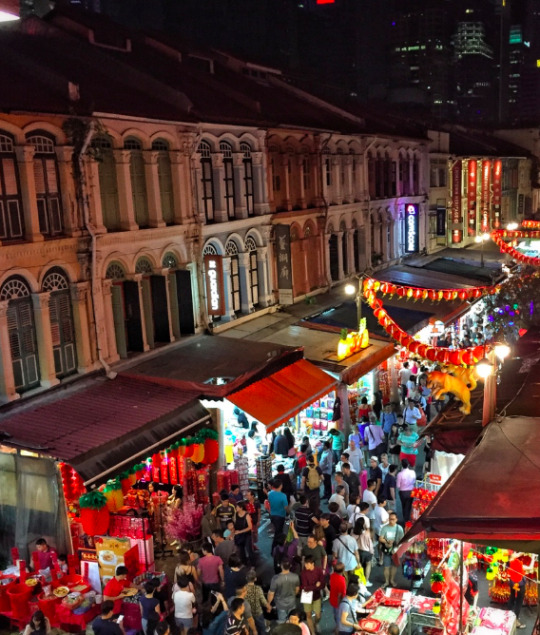
Chinatown in Singapore
In every direction I looked I saw red, the official colour of Chinese New Years, and a symbol of luck and good fortune. I wove through the crowds and under hundreds of swinging lanterns, finally locating my hostel for the evening. I hadn’t realized it at the time of booking, but my hostel was actually on the second storey of one of these historic shophouses, with my room looking directly out over Pagoda Street. While this made for some very cool pictures, and a birds-eye view of the festivities below, it also ended up being very loud! Over the rest of the week, earplugs and a loud fan became my best friends – allowing me to get some much-needed shut-eye while the New Years’ revelry carried on late into the night. Despite this small inconvenience, it was very cool to be in Singapore during this time, and get an inside look at the country’s celebrations!
After checking in, I returned to the bustling streets to explore. Although I was tired for my long flight, my senses were jolted awake from the sights, smells and sounds of Chinatown – steaming baskets of dim sum and street food, red envelopes for “lucky money”, a traditional gift for children during New Years, the pungent smell of durian fruit, and a canopy of lanterns criss-crossing the night sky overhead.
I capped off my evening with chicken rice and dim sum at Maxwell Food Centre, one of the many hawker markets that Singapore is famous for. Scattered around the city, these local food halls are home to some Michelin-starred food stalls – with all eats usually under $10! It was a delicious way to start off my travel in Southeast Asia.
Day 139 – Singapore
My first full day started with life admin – getting set up with a new SIM card, a replacement tote bag and new set of reading glasses, after I accidentally stepped on mine when camping in New Zealand! I had to be in Singapore for almost a week because of the timing for my second set of vaccinations – Rabies and Japanese Encephalitis - specific to my next two months in Southeast Asia. Although I wasn’t originally planning to be in Singapore for this long, it was a nice change of pace, as I didn’t feel rushed to see everything at once.
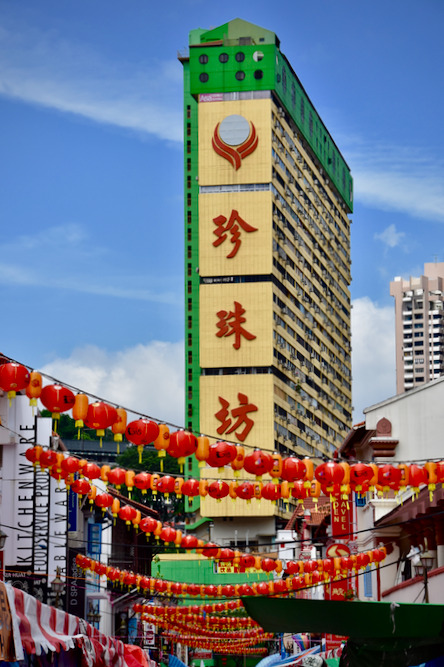
Chinatown
I wandered around Chinatown and downtown Singapore during that daytime, and began to get an even clearer picture of Singapore’s rich cultural diversity, from the countless options for ethnic cuisine, to numerous places of worship for Hindu, Buddhist, Muslim and Christian faiths – often all within a few blocks. It is clear that Singapore’s culture is an incredible fusion of culture, ethnicity, faith, and language. The blend of Malaysian, Indian, Chinese, Arab and English cultures is on full display at every turn throughout this vibrant “Lion City”.
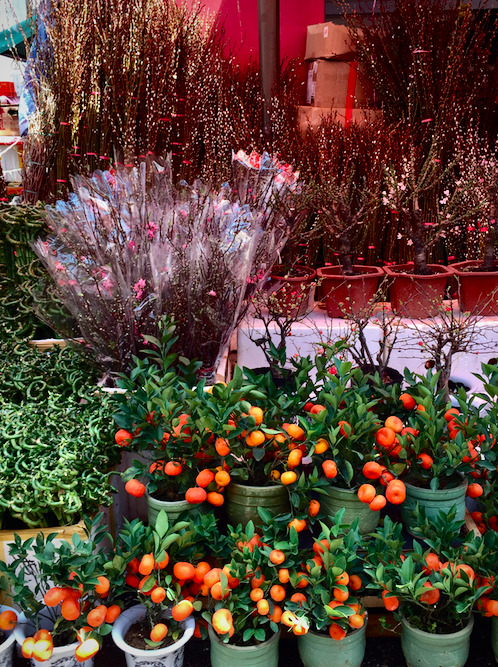
Kumquat Plants on Pagoda Street
Walking through the heart of Chinatown, I first explored Sri Mariamman Temple, the oldest Hindu Shrine in Singapore. It was originally built in 1827 by an Indian trader from Penang, Malaysia, and the Dravidian architecture of the temple was simply stunning. This particular style of temple originated from South India and Sri Lanka, with the architecture consisting of pyramid shaped towers throughout the temple. The Sri Mariamman Temple stands out with its large gopurum (monumental entrance tower). The massive gopurum had numerous tiers, consisting of brightly coloured sculptures of Hindu deities.
Covering my shoulders and taking my shoes off, I walked through the heavy wooden gates to enter the temple. I wandered into a courtyard with the main prayer hall located in the centre, where there were large sculptures of deities such as Rama, Muraga and Krishna. Flower garlands, called “mala” had been placed around the necks of these deities by devotees.
Heading over a few blocks, I walked around the perimeter of Buddha Tooth Relic Temple, a 5-story, modern Buddhist Temple. Built in 2007, the temple gets its name from what is thought to be the tooth of Buddha (recovered from his funeral pyre in India), which is displayed in the temple. Thousands of red lanterns encircled the base of the temple, swinging in the breeze.

Clarke Quay
I continued onwards to Clarke Quay, located on the banks of the Singapore River. Once the heart of the city and a centre for marine trade and commerce, this neighbourhood is packed with both colonial-era architecture and colourful modern buildings. Visitors to Clarke Quay can still ride the historic “bumboats” that were used to unload wares from around the world. I wandered along the walkways lining the river, taking in the sights of this diverse neighbourhood.

MICA Building in Clarke Quay
In the late afternoon, I boarded the MTR to head up to Emerald Hill. Located near the famous shopping district of Orchard Road, Emerald Hill is a peaceful conservation area, filled with cobblestoned streets and beautifully preserved Peranakan shop houses, complete with grand entrance gates, sculpted, colourful wall decorations, and wooden window shutters. Beautifully tended gardens with lush, tropical vegetation surrounded the buildings, adding to the beauty of this neighbourhood. In front of some of the homes, there were touches of red decorations, in celebration of the New Year. Kumquat plants were outside the front doors, decorated with red ribbons for luck, their yellow-orange fruit symbolizing prosperity.

Emerald Hill
A few of the shophouses on Emerald Hill had been converted into trendy patios and cafes, where I stopped at one for a glass of wine, taking in the peaceful ambience of the neighbourhood. As evening fell, I returned to the hubbub of Chinatown, sampling street food on Smith Street and popping in and out of bustling stalls and shops, before making my way home for the evening.
Day 140 – Singapore
It was a hot, humid morning as I boarded the MRT, heading to Eunos Station in Eastern Singapore. My destination was the Joo Chiat, located on the Eastern side of the island, a neighbourhood considered to be one of the early heritage towns in the country. It is also known for being a Peranakan community, an ethnic group descended from marriages between Chinese and Indian men and local Malay or Indonesian women from the Malaysian Archipelago (with Singapore at its base).
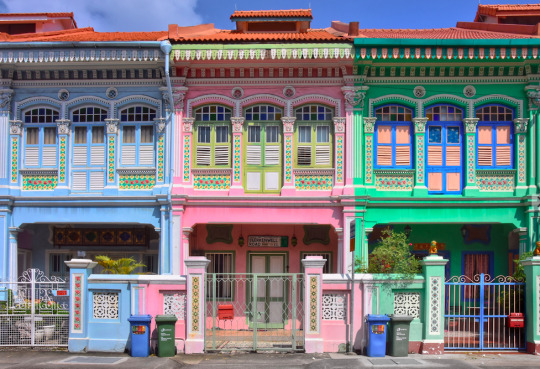
Joo Chiat
In Joo Chiat, the neighbourhood is full of colourful homes decorated with ceramic tiles and sculpted facades. These heritage homes are juxtaposed with trendy bars and modern shops, sprinkled throughout the neighbourhood. I walked along Koon Seng Road to visit the famous stretch of Peranakan shophouses. Built in the 1920s, these 3-storey homes are painted in various pastel shades, with intricate floral patterns decorating the exteriors.

House of Tan Teng Niah
Because I love a good walk when travelling, I decided to head back towards the city centre on foot, which was a great way for me to get a sense of everyday life in the Singapore. I stopped in Little India in the early afternoon to visit the house of Tan Teng Niah. Constructed in the early 1900s by a local businessman, this villa is an example of a home of many of Singapore’s ethnic-Chinese business around the turn of the century. When it was restored about 30 years ago, it was painted in a rainbow of vivid colours – with every section of the house in a slightly different hue. It was quite a striking sight!
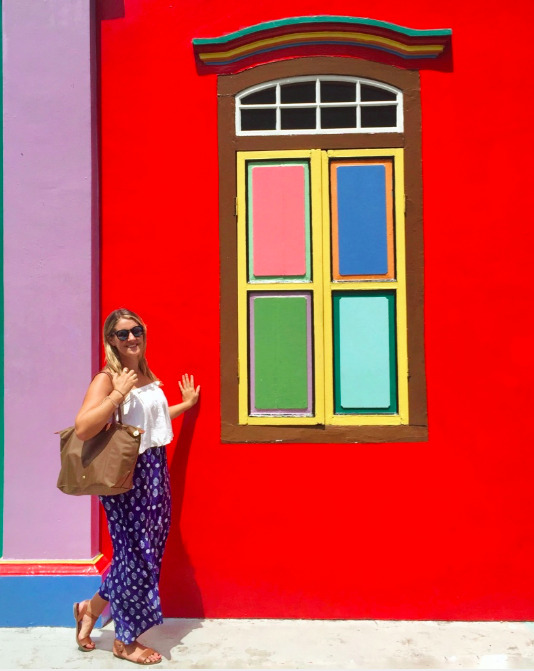
I continued onwards to Kampong Gelam, a neighbourhood which has been home to the Malay, Arab and Burgis communities of Singapore since the 1800s. Today, the area is one of Singapore’s creative hubs, packed with street art, independent boutiques, and trendy pubs and bars. In addition to being a popular hipster hangout, Kampong Glam also is host to many colourful heritage and worship sites. Arab Street, part of Singapore’s Muslim Quarter, is packed with stores selling wares such as Persian Rugs, intricate textiles and Arab teas. It is an area that has fusion of culture, religion and people, and definitely has something for everyone.
Nearby, the spectacular Masjid Sultan Mosque is framed by swaying palm trees. Considered to be the “national mosque” of the city-state, it has a history of over 200 years, with several versions of a mosque having been built on the grounds. The current Masjid Sultan Mosque was built in the 1930s, and has an iconic gold dome, flanked by a tall minaret with a gold roof.
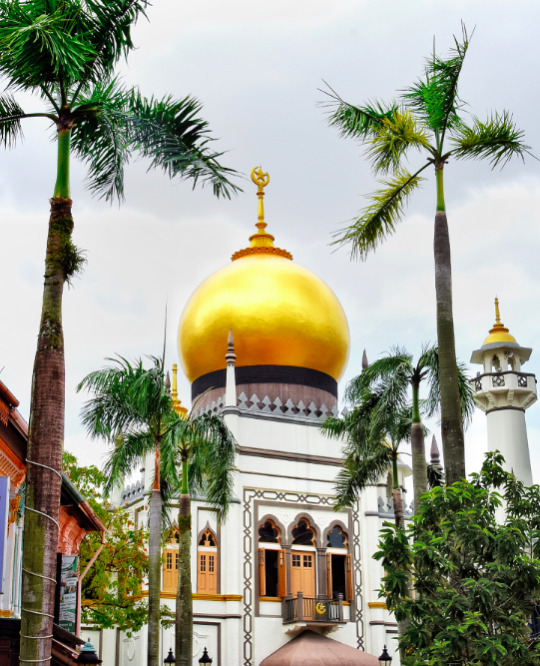
Masjid Sultan
I stopped for dinner and a Tiger beer at the patio of a jazz café, tucked along an alley with extravagant and street art, people watching and taking in the sights and sounds of Kampong Gelam. Tired from the humidity and my long day of walking, I hopped on the MRT and headed back to my hostel in Chinatown.
0 notes